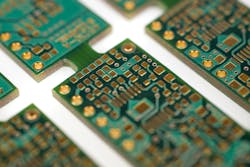Engineering Startup Makes PCBs Accessible to Next-Generation Electrical Engineers
Every circuit design project starts somewhere, whether it’s breadboarded or built up bug-style. Eventually, that project will need to be prototyped. Gerber Labs, a startup based in Tustin, CA, is rolling out a platform that makes custom printed circuit boards (PCBs) accessible to electrical engineering students, hobbyists, and small businesses.
Getting your hands on a custom PCB can sometimes present hassles. If you’re a large business or manufacturer, a traditional PCB house will spin you a prototype in anticipation of a large order down the road. But that often entails working through salespeople and/or overseas reps. PCB’s traditionally have only been accessible for large businesses and manufacturers. Gerber Labs is changing this by making PCBs available in prototype quantities to the consumer and small-business markets.
On the company’s website, ordering a PCB is as simple as uploading, yes, you guessed it: a Gerber file of the board layout. Gerber Labs can produce 2- or 4-layer PCBs that follow their design rules. The basics: maximum board size is 500 x 500 mm with trace width and spacing of 0.15 mm. If you’re new to ordering PCBs, the site offers some resources to help you get started.
As part of its launch, Gerber Labs is working with universities across the country and their engineering student body to help create PCBs for varied engineering competitions and project needs.
Gerber Labs, www.gerberlabs.com
About the Author
David Maliniak
Executive Editor, Microwaves & RF
I am Executive Editor of Microwaves & RF, an all-digital publication that broadly covers all aspects of wireless communications. More particularly, we're keeping a close eye on technologies in the consumer-oriented 5G, 6G, IoT, M2M, and V2X markets, in which much of the wireless market's growth will occur in this decade and beyond. I work with a great team of editors to provide engineers, developers, and technical managers with interesting and useful articles and videos on a regular basis. Check out our free newsletters to see the latest content.
You can send press releases for new products for possible coverage on the website. I am also interested in receiving contributed articles for publishing on our website. Use our contributor's packet, in which you'll find an article template and lots more useful information on how to properly prepare content for us, and send to me along with a signed release form.
About me:
In his long career in the B2B electronics-industry media, David Maliniak has held editorial roles as both generalist and specialist. As Components Editor and, later, as Editor in Chief of EE Product News, David gained breadth of experience in covering the industry at large. In serving as EDA/Test and Measurement Technology Editor at Electronic Design, he developed deep insight into those complex areas of technology. Most recently, David worked in technical marketing communications at Teledyne LeCroy, leaving to rejoin the EOEM B2B publishing world in January 2020. David earned a B.A. in journalism at New York University.

